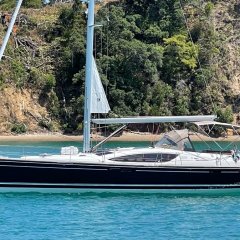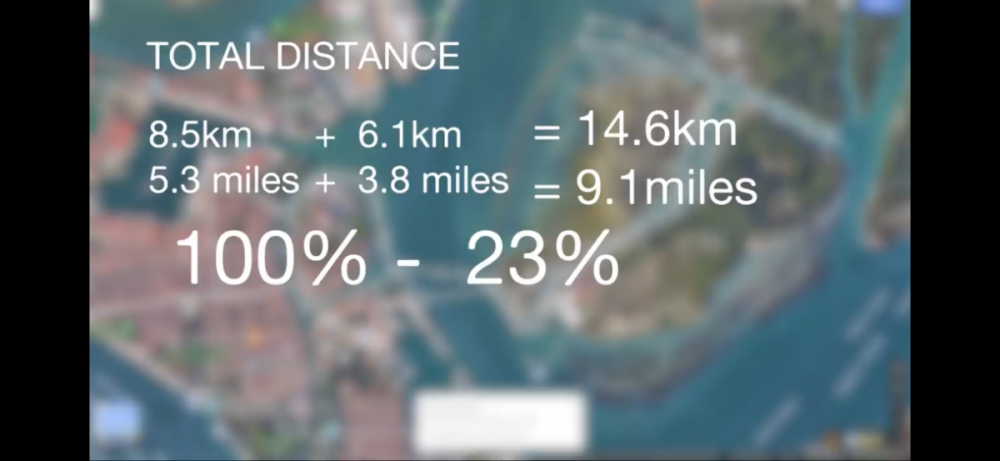-
Content Count
4,296 -
Joined
-
Last visited
-
Days Won
47
Content Type
Profiles
Media Demo
Forums
Gallery
Calendar
Store
Posts posted by Fogg
-
-
Just out of curiosity how much does an inspection cost (if anything)? And where does the money go?
-
Ok that’s cool, it lists suitability of vessel and crew as two totally separate things. Which makes sense if the vessel is assessed in isolation and then the proposed crew is discussed.
I just misunderstood you guys because I thought I heard you saying is that you had (1) experienced and (2) supported the concept that these two assessments are intertwined ie that the boat might be assessed as ‘nearly suitable’ but if the crew were assessed as especially strong then this could overcome the vessel’s shortcomings.
So in summary both the vessel and the crew must be assessed as suitable to get the green light to go but the 2 assessments do not influence each other.
So the only question remaining in my mind is whether the Cat 1 certificate relates to the boat itself (as I think it should) or not? And so what you need to depart is (1) Cat 1 vessel and (2) offshore approved crew?
And maybe when people say “I’ve got Cat 1” what they really mean is that they got approval to depart which means both a Cat 1 vessel plus approved crew (which is 2 different approvals side-by-side)?
-
-
So someone is going to put some dry white powder into an envelope and send it to someone else?
Please let us know when this is going to happen. I’ll be watching the news with great interest (for a change)…
-
 2
2
-
-
This sounds like muddling two sets of requirements.
The Cat 1 inspection should be just for the boat and it should either be compliant or not. Totally independent of crew. This is the way we approve the safe use of other vehicles for their intended purpose including cars and aircraft for example. You don’t get a WOF for your car if it’s in sh!t state but you’re a great driver, do you?! And can’t do a self-declaration that because you’ve been driving for 25 yrs you can self-certify your car is safe. That would be ludicrous. So why apply it to boats?
Then you should have a totally separate matter of whether the skipper & crew are suitably experienced for the intended journey. That last bit is the key. For coastal cruising around NZ there is no formal requirement for experience so anyone can go coastal sailing even beginners. But for offshore it sounds like there is already a requirement under YNZ ie at least one person in the crew must meet the requirement for the intended trip. And that sounds reasonable although it opens a new question of how to prove it adequately. But either way the crew’s suitability to undertake the trip should remain totally independent to the certification of the boat. The Cat 1 certificate shouldn’t be a bundled package of boat + crew because the latter can change at any time.
-
16 hours ago, Black Panther said:
Makes sense. Similarly how about some credit for ocean miles covered by a skipper/owner?
Mmm, isn’t that going down the wrong path? Shouldn’t the certification be 100% for the boat independent of the owner / skipper / crew?
Because if you follow that logic to its conclusion you could end up with a scenario whereby an inspector effectively says “Well this boat meets Cat 1 if it’s sailed by person X (with for example 25 yrs / 50,000nm offshore experience) but it fails if sailed by a person with lesser experience.”
-
I’m certainly much more wary of so-called main agents in NZ. Just before Fogg arrived last year I knew I needed an anode for my Maxprop and was told I should go to NZ Maxprop agent (Sopac). I bought said anode for about $120.
Literally next day I happened to be in Burnsco GH when I spotted a whole tray full of the damn things. See photo below for their price. So I bought one there.
And I was annoyed enough that I drove straight back to Sopac and complained about their ludicrous markup (2x Burnsco’s price)! To be fair the guy I saw did mumble an apology and gave me a full refund when I showed him the evidence.
-
Be interested to hear what your experience is buying direct like this in terms of final landed cost for a part and time to arrive (compared to buying locally)?
I recently bought a small but essential part for Fogg - not going to get too specific because I don’t want to name names - I went through the main NZ agent who told me it was going to take 2-3 weeks coming in from Asia. I ordered and started waiting. Then lockdown came. I tried contacting said agent but was told they weren’t officially operating. Then I discovered they had ordered it through another NZ business who was actually doing the importing. So that’s 2x ‘middle-men’ in the picture already here in NZ without counting what’s going on at the other (originating) end.
This seems like unnecessary duplication. If you’re a main NZ agent for a major global brand surely you should set yourself up to be capable ordering & importing parts yourself from overseas not outsourcing that too?
Whenever we challenge the comparative cost of stuff in NZ we get fed sob stories about importing costs and unidentified ‘middle-men’ etc. But it looks like NZ operators aren’t exactly helping themselves at this end of the supply chain?
-
Port congestion is a global thing not just NZ…
-
28 minutes ago, DoT said:
Do you really think that caring about your personal impact on climate change is being "some kind of eco-warrior"?
What narrative would you prefer your kids to get? Climate science is a giant conspiracy by greedy academics who hate our freedom to burn things?
Ok so someone took me seriously 😳.
Sorry!
-
32 minutes ago, Psyche said:
Be interesting to see how the range changes as the battery degrades.
Given it’s lithium I presume similar to a phone ie if looked after properly maybe ~5yrs but depends on cycles?
-
My instinct is that the e-outboard will literally be on the tender (which is on the davits) for 90% of time. The super light dinghy + o/b combo (total weight less than 50kg) making the lift & drop super-easy.
The switch to the Yammy will be a rare occurrence - probably more to give it an occasional run than because I really need it.
If I haven’t used it after 2 seasons I’ll sell it. Or if you e-outboard is a disappointing flop then I’ll sell both of them, admit defeat, and go back to a Yammy 8hp 2S as a middle ground (had one a few years ago and was a v sweet unit).
-
2 hours ago, SloopJohnB said:
Good old fusel fuels.😉 We can't do without them.
Yes don't get me wrong, I'm not buying an electric outboard to be some kind of eco-warrior 😇, it's purely a convenience thing. But I'm sure I will get some brownie points from the kids because as a convenient consequence e-power aligns with the narrative being 'fed' to them at school.
I do particularly enjoy dropping off my 6yr old in my 4.4L V8 amongst all the Teslas and hybrids. 😉
-
For anyone who didn’t watch the video the guy found that after 2 trips totally about 9m (14.5km) the ePropulsion’s battery was down to 23% remaining capacity. And he was driving mostly between 75% and full-throttle with some time at lower speeds.
He also showed how it could be recharged by either:
1. Mains
2. 12v cigarette lighter
3. Plugging into one the ship’s existing solar panel (using optional extra MPPT solar controller)
4. Plugging into portable / folding solar panel (another optional extra)
In a later episode he also shows how it can be recharged using hydro generation by leaving the engine down whilst towing the dinghy - but he told me they don’t use this option very much and prefer solar mostly.
This kind of range / endurance even at higher speeds (5-6kts) means it would easily last all day on a typical busy family summer day ferrying people around the anchorage - and could easily be recharged overnight (8.5hrs for a complete recharge).
But if I ever know I need a faster / longer range to take the family exploring I can just swap it over for my Yammy 15hp 2S for the day.
-
Superb!
-
Come summer I’m releasing myself whatever the govt is saying.
As Thomas Jefferson (3rd president of the USA) said “A little rebellion now and then is a good thing.” 😊
-
 1
1
-
 1
1
-
-
The price of the unit I have my eye on (above) is around $3,600. Which is a hefty price for a small ~3hp unit and not to everyone’s taste. But to me the premium is worth paying to get the lightness and ease of use (especially for rest of my family who are not confident using a pull chord to start a petrol outboard). So for me the justification is that I’m not comparing like-with-like, I’m buying a totally different animal.
Even better, for the reasons of ease of use, it has family approval to spend the $ and they’re looking forward to trying it! 😊
-
ICNZ? As in Insurance Council of New Zealand?
-
After a few days research I've decided to go with ePropulsion (still deciding on the Spirit Plus vs the slightly newer Evo).
I spoke to a few people who have used both ePropulsion and Torqeedo and they both seem to be good quality units with their own pros & cons.
The Torqeedo fans will point to it's German heritage and longer track-record. Whereas fans of the newer ePropulsion point out that the company originates from the same (Chinese) incubator that gave birth to DJI Drones (the world's largest & most successful drone company). And whilst newer, the early signs of ePropulsion are encouraging with several examples of design detail enhancements happening quite quickly in response to customer feedback being listened to.
In terms of side-by-side comparison the points that swung it to ePropulsion for me:
1. Bigger battery (40% more)
2. Longer-run time (50% more)
3. Faster charge time (about 20% better I think)
4. Cheaper
5. A couple of cool innovative features e.g. the battery floats in case you accidentally dropped it into the drink!
And finally, I have a lot respect for this guy who reviews a lot of high quality gear (anchors, dinghies, charging systems, outboards etc). And his initial experience with ePropulsion has been great. And I talked to him overnight and he confirmed that after more time it's still all as good as it looked & operated on day 1. So if it's good enough for him it's good enough for me!
-
 1
1
-
 2
2
-
-
Anyone know if the Auckland dams are full again? Because the drought brigade seem to have gone quiet recently!
-
-
That’s the spirit.
-
 1
1
-
-
Ok thanks email sent.
-
Glad I’m not the only one who browses MarineTraffic now & again!
-
 2
2
-







Fatality - Northland
in MarineTalk
Posted
Thanks (how silly of me I should have asked earlier)!
Suddenly it all makes sense now…